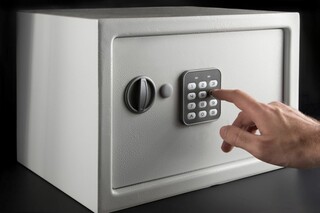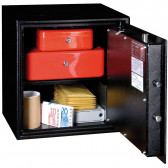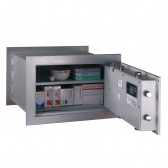Just a few years ago, a home safe was considered an extravagant item designed mainly for wealthy individuals. However, times are changing fast and more and more people are starting to realise that a safe should be a compulsory piece of equipment in every modern home.A certified armoured cabinet with a high security class will allow you to rest assured about your valuables and possessions. When you go on holiday, you will no longer fear robbery, and the certainty that your money, jewellery and other valuables are well protected will give you a peaceful night's sleep.
What can you keep in a safe?
A common misconception is that you buy a safe to keep mainly money in it. In fact, you can store anything that is of value to you in a safe. Memorabilia and photographs are things that have emotional value. They may be worthless to strangers, but to the owner they are often worth more than cash.
Classified documents can also be kept in a safe. Regulations on the protection of classified information (GDPR) have made it mandatory for every employer to protect their employees' data. Disclosure or loss of personal data can end up with criminal consequences. Private individuals should also secure important documents such as notarial deeds, extracts from the land register, civil status records, passports, important bank contracts.
Some people keep expensive jewellery in caskets hidden in dressing tables in the bedroom. Thieves know this and during a burglary they check these places first. If you want to make sure that your valuables do not fall prey to a robber, store them in a safe.
You can also keep collections of stamps or coins in an armoured locker. Some people want to protect souvenirs, works of art and antiques. Gun owners, on the other hand, are obliged by law to keep their weapons and ammunition in safes with a minimum security class of S1. If you are looking for the perfect security for your home then take a look at the "home safes" category at Hartmann Tresore!
How to hide a safe at home
You already know that it is worth having a safe at home. Where to hide it is quite another matter. Armoured safes are designed to be fitted into furniture. If you have a large wardrobe, you can hide the safe in your wardrobe.
Another idea of where to hide the safe is to mount it in the bedroom. The best places to put an armoured cache are rooms that are only accessible to household members. This could be a private study, library or cellar. The safe must always be fixed to the floor.
If you are in the process of building a house, this is the best time to think about where to hide the safe. You can plan to build it into the wall or place it under the floor. Installing a wall safe in an existing building is not so easy, as it may require additional investment in the form of reinforcing the wall structure. However, everything is possible and the safe can be placed in the wall even in the flat of a multi-family building.
Hunters have a big problem with how to hide a safe at home. Rifles with sights take up a lot of space. In addition, every hunter has at least two weapons: a smooth-bore rifle for shooting pellets and a rifled gun for big game. Keeping even two pieces of hunting equipment requires a large cupboard, which is difficult to hide.
It should also be remembered that ammunition, documents allowing the purchase of weapons and proofs of purchase of armament are kept in an armoured cupboard. It is best to allocate a separate room or basement for the hunting weapon safe or cabinet. In addition to arms and ammunition, hunting equipment and trophies can be kept in a special room.
What should I look for when buying a safe?
The most important consideration when buying a safe is the security class. Some metal safes are not certified as burglary resistant and you cannot be guaranteed protection with them. The lowest safe class is S1. Armoured safes with this class are used to store weapons, among other things.
The higher the burglary resistance class, the more expensive items you can store. If you're planning on storing very expensive items, ask your property insurer for the protected value limit for a particular safe model before you buy.
The purpose of the safe is also important. A different model will be suitable for storing documents and cash, and another for weapons and ammunition. If you want to store paper documents, consider buying a fireproof safe.
Consider choosing the size of the safe. You may not need a large cabinet for the moment, but remember that you may want to store more valuables in the future. It may be a good idea to buy a larger safe. Remember that a larger safe deposit box will be more convenient and easier to keep tidy.
Which lock to choose for your safe?
You already know how to hide a safe at home and what to look for when buying one. There is still the question of choosing a lock. Despite appearances, this is not so simple. First of all, you need to know that locks also have a security class. Look out for the EN 1300 certificate.
The safe can be fitted with one of the following locks:
● a standard key,
● a mechanical lock with a traditional dial,
● electronic with a numerical keypad,
● biometric with a fingerprint,
● electronic with smartphone control.
The question of where to hide the safe is important, but you can't forget about the burglary resistance class and the purpose of the box. The method of locking the safe is also very important, both for security and convenience. Take all these criteria into account so that you can enjoy the purchase of a functional and, above all, secure safe.
You may be interested in: Which lock to choose for safes?
Home or flat safes – what to buy so you don't regret it
From purchase to first use of the safe. Avoid errors during transport and installation





